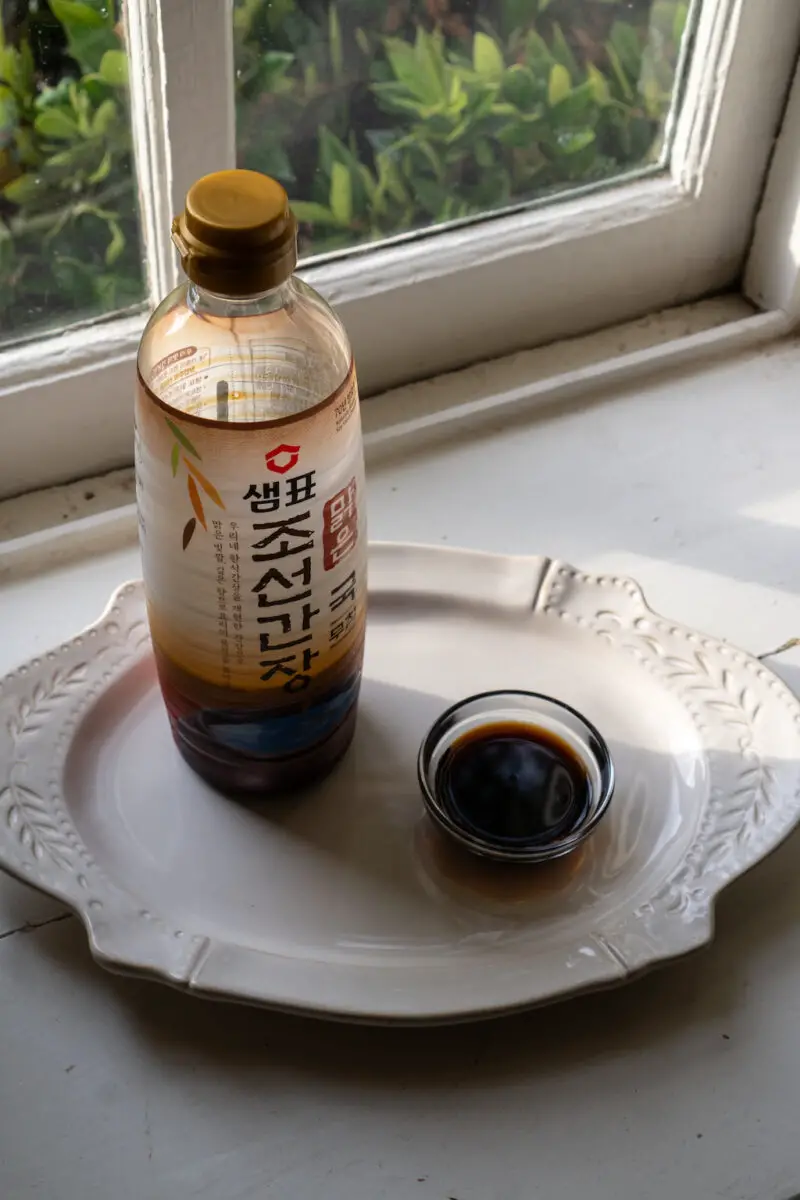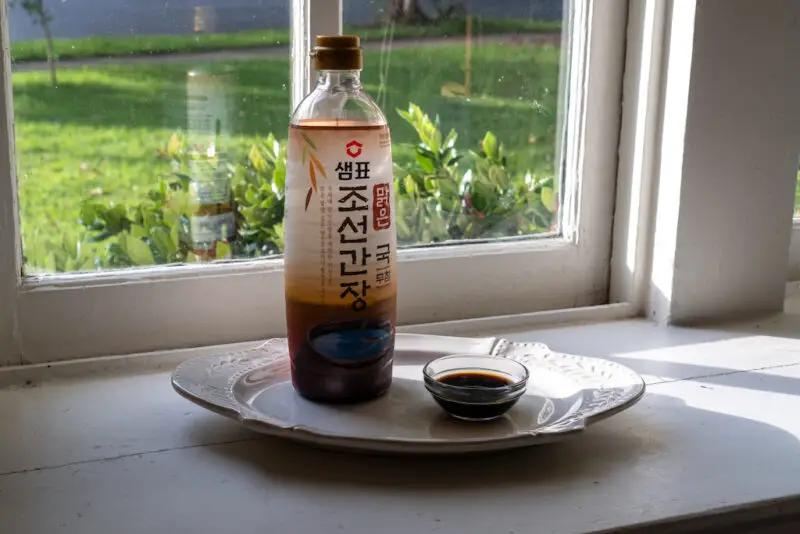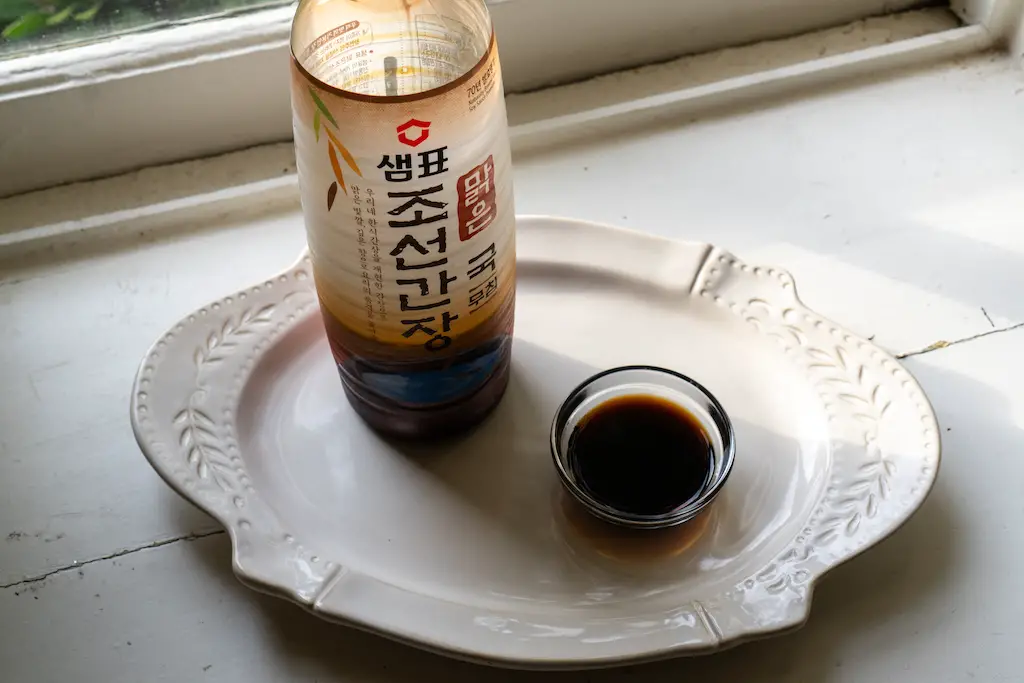This post may contain affiliate links. Please read my disclosure for details at the bottom of this page. As an Amazon Associate, I earn from qualifying purchases on this article about guk ganjang, otherwise known as Korean soup soy sauce. I hope you enjoy learning about this ingredient!
What Is Guk Ganjang?
Soup soy sauce, known as ‘guk ganjang’ (국간장) in South Korea, is an ingredient used to season soups and stews in South Korea. Historically made entirely of soybean and brine, soup soy sauce is a byproduct of making doenjang, and vice versa.
To make both, people in Korea start by preparing ‘meju’ (메주), a thick brick made of dried and fermented soybeans, in early to mid-November. To make this meju, you start by soaking the beans overnight before boiling them in saltwater. Then, you either pound the soybeans with a mortar or grind them in a millstone. Next, people shape the soybean mash into a cube or thick sphere known as ‘meju’ bricks. Finally, they dry these bricks in a cool, dark area for a period until firm.
Once hardened, they then traditionally tie the meju blocks with rice straws to the eaves or beams of the home. (Cultural Note: Different areas of Korea have different traditions of how to hang or dry the meju bricks.)
Finally, the meju sits in a jangdok (also known as onggi) with brine to age, often with added ingredients, such as charcoal or chilies, for their antibacterial properties. Once fermented, you filter and boil the excess liquid which becomes Korean soup soy sauce while the aged meju chucks are further mashed down to become doenjang.
Though lighter in color than traditional soy sauce, soup soy sauce tastes richer and saltier, which is perfect for seasoning large pots of soup and stew.
Note: Learn more about different soy sauces in Korean cooking via my article on the subject!

Note to Be Confused With:
- Korean Regular Soy Sauce (Jin Ganjang)
- Japanese and Chinese Soy Sauce Brands
- Tamari
Soup Soy Sauce in Korean Cuisine:
Once again, people in Korea refer to this ingredient as ‘guk ganjang’ (국간장). Most commonly, people in Korea use guk ganjang to season the broth of soups and stews.
Some Examples of Guk Ganjang in Dishes Include:
- Miyeok Guk (미역국): Literally meaning ‘seaweed soup,’ this dish is made by cooking seaweed in a thin broth. Often this soup also contains bite-sized pieces of stew beef or shellfish (such as clams). Guk ganjang is used to help flavor and salt miyeok guk. You can also learn about seaweed in Korean cooking via my article on the subject.
- Tteokguk (떡국): In English, we can translate this to ‘rice cake soup.’ People make this soup during Korean New Year’s! Like miyeok guk, you can season the broth with soup soy sauce.
Korean Soup Soy Sauce Frequently Asked Questions:
Now that we learned about guk ganjang, I want to also answer some questions you may have about this ingredient! If I do not answer your question, feel free to leave a comment in the section below or email me at [email protected].
What Does Soup Soy Sauce Taste Like?
Korean soup soy sauce contains a higher sodium content than regular soy sauce alternatives. This works well in soups and stews because it helps season broth-based dishes. Soup soy sauce also tastes richer.
Where Can I Buy This Ingredient?
While you can find regular soy sauce at most well-stocked grocery stores, it may be difficult to find Korean soup soy sauce. Instead, try shopping at your local Asian market or Korean grocery store.
If you do not live near an Asian grocery store, you can easily find this ingredient for sale online! I usually by this ingredient via Amazon!
Where to Buy Korean Ingredients Online?
Nowadays, there are many online options to choose from to order Korean food online. These websites are not limited to but include:
- Amazon
- H-mart
- Hanpoom
- Wooltari
How Do I Properly Store Korean Soup Soy Sauce?
Prior to opening, you can store this ingredient in a cool, dark place (such as a pantry). Once opened, I recommend putting it in the refrigerator.
What Is a Good Guk Ganjang Substitute?
Unfortunately, there isn’t really an exact substitute for guk ganjang. Instead, you can use regular soy sauce or tamari to flavor your Korean soups and stews. Just note that the sodium levels and flavor differ between the two.

I Hope You Enjoyed Learning About Guk Ganjang in Korean Cooking!
In the end, I hope you enjoyed learning about the uses of guk ganjang in Korean cuisine. If so, let me know in the comment section!
If you would like to read more about cooking, you can find recipes as well as further Korean ingredient articles on my blog. I listed some of our favorite Carving A Journey recipes below! For reference, many recipes are influenced by my family’s blended Korean and Southern heritage.
Korean Ingredient Articles:
- Ginger in Korean Cooking (Saenggang)
- Bokbunja (Korean Blackberry)
- Lotus Roots (Yeongeun)
- Korean Dried Radish Strips (Mumallaengi)
Further Carving A Journey Recipes:
If you have any questions or comments, you can also email me at [email protected]. And, finally, I would love to hear from you through our social media as well! You can follow me at @carvingajourney on Instagram, Facebook, and Pinterest. I also started a vlog Youtube channel with my husband! Or, if you would like more articles like these, you can subscribe to the blog by joining the mailing list. Let me know if you try cooking food using Korean soup soy sauce (guk ganjang)! Thank you so much for stopping by!
Carving A Journey is a participant in the Amazon Services LLC Associates Program, an affiliate advertising program designed to provide a means for sites to earn advertising fees by advertising and linking to Amazon.com. Although we may earn commissions for our endorsement, recommendation, testimonial, and/or link to any products or services from this website, these opinions are my own and I fully support these products.

